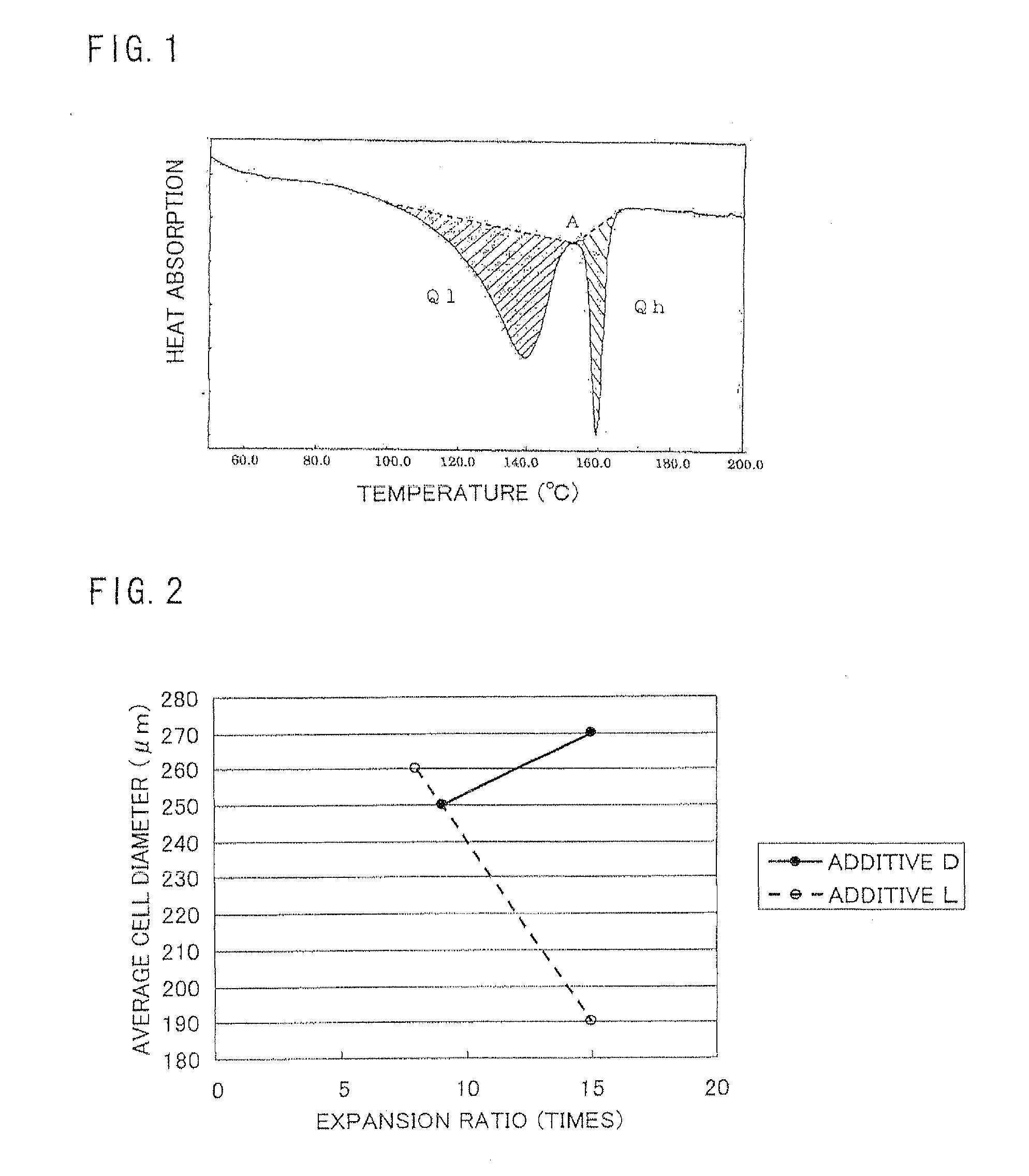Process for Producing Expanded Polyolefin Resin Particles and Expanded Polyolefin Resin Particles
a technology of polyolefin resin and polyolefin resin, which is applied in the direction of thin material processing, transportation and packaging, etc., can solve the problems of high cost of facilities, insufficient fusion, high expansion ratio, and high rate of fusion, and achieve high expansion ratio and easy control of expansion ratio. , the effect of high expansion ratio
- Summary
- Abstract
- Description
- Claims
- Application Information
AI Technical Summary
Benefits of technology
Problems solved by technology
Method used
Image
Examples
example 1
[0224]Polyethylene glycol (having an average molecular weight of 300; manufactured by Lion Corporation) was pre-blended in 0.5 parts by weight to 100 parts by weight of polypropylene resin A (propylene-ethylene random copolymer: ethylene content of 3.0%, MI=6 g / 10 minutes, melting point of 143° C.). In addition, talc (manufactured as Talcan Powder PK-S by Hayashi-Kasei Co., Ltd.) was blended as a foam nucleating agent in 0.05 parts by weight. The mixture was supplied to a single screw extruder 50 in diameter, melted and kneaded, extruded through a cylindrical die 1.8 mm in diameter, cooled with water, and then cut with a cutter to give cylinder-shaped polypropylene resin particles (1.2 mg / particle).
[0225]Into a pressure-resistant closed vessel, 100 parts by weight of the polypropylene resin particles thus obtained were fed together with 200 parts by weight of pure water, 1.0 part by weight of tertiary calcium phosphate, and 0.05 parts by weight of soda dodecylbenzenesulfonate. After...
example 2
[0228]Foaming, second-stage foaming, and in-mold expansion molding were carried out in the same way as in Example 1, except that the additive, polyethylene glycol (having an average molecular weight of 300), and talc were used in 0.2 parts by weight and 0.1 part by weight, respectively. The first-stage expanded particles showed, two melting points, had an expansion ratio of 15 times and an open cell ratio of 0.7%, were excellent in uniformity of cells, and had an average cell diameter d of 270 μm. The moisture content was 2.0%. Next, second-stage expanded particles having an expansion ratio of 30 times were obtained in the same way as in Example 1. The second-stage expanded particles showed two melting points in differential scanning calorimetry, had an open cell ratio of 0.8%, and were excellent in uniformity of cells with an average cell diameter d of 375 μm. As a result of the evaluation of in-mold expansion molding, the in-mold expanded molded product thus obtained was found to ...
example 3
[0229]Foaming, second-stage foaming, and in-mold expansion molding were carried out in the same way as in Example 1, except that the additive, polyethylene glycol (having an average molecular weight of 300), was used in 0.1 part by weight. The first-stage expanded particles obtained by the first-stage foaming showed two melting points, had an expansion ratio of 11 times and an open cell ratio of 0.7%, were excellent in uniformity of cells, and had an average cell diameter d of 275 μm. The moisture content was 1.3%. Next, second-stage expanded particles having an expansion ratio of 30 times were obtained in the same way as in Example 1. The second-stage expanded particles showed two melting points in differential scanning calorimetry, had an open cell ratio of 0.8%, and were excellent in uniformity of cells with an average cell diameter d of 420 μm. As a result of the evaluation of in-mold expansion molding, the in-mold expanded molded product thus obtained was found to have a surfac...
PUM
| Property | Measurement | Unit |
|---|---|---|
| temperature | aaaaa | aaaaa |
| average cell diameter | aaaaa | aaaaa |
| average cell diameter | aaaaa | aaaaa |
Abstract
Description
Claims
Application Information
 Login to View More
Login to View More - R&D
- Intellectual Property
- Life Sciences
- Materials
- Tech Scout
- Unparalleled Data Quality
- Higher Quality Content
- 60% Fewer Hallucinations
Browse by: Latest US Patents, China's latest patents, Technical Efficacy Thesaurus, Application Domain, Technology Topic, Popular Technical Reports.
© 2025 PatSnap. All rights reserved.Legal|Privacy policy|Modern Slavery Act Transparency Statement|Sitemap|About US| Contact US: help@patsnap.com


